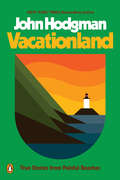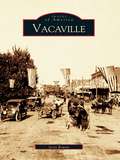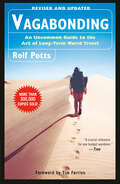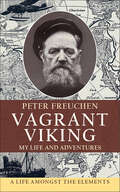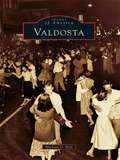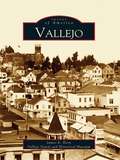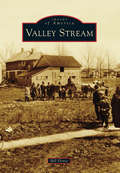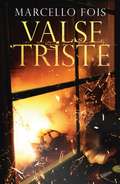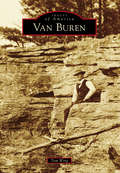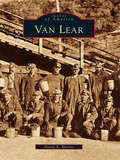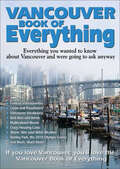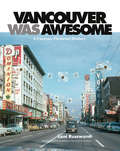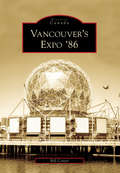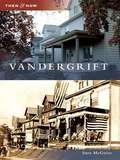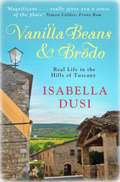- Table View
- List View
Vacationland: True Stories from Painful Beaches
by John HodgmanAlthough his career as a bestselling author and on The Daily Show With Jon Stewart was founded on fake news and invented facts, in 2016 that routine didn’t seem as funny to John Hodgman anymore. Everyone is doing it now. Disarmed of falsehood, he was left only with the awful truth: John Hodgman is an older white male monster with bad facial hair, wandering like a privileged Sasquatch through three wildernesses: the hills of Western Massachusetts where he spent much of his youth; the painful beaches of Maine that want to kill him (and some day will); and the metaphoric haunted forest of middle age that connects them. Vacationland collects these real life wanderings, and through them you learn of the horror of freshwater clams, the evolutionary purpose of the mustache, and which animals to keep as pets and which to kill with traps and poison. There is also some advice on how to react when the people of coastal Maine try to sacrifice you to their strange god. Though wildly, Hodgmaniacally funny as usual, it is also a poignant and sincere account of one human facing his forties, those years when men in particular must stop pretending to be the children of bright potential they were and settle into the failing bodies of the wiser, weird dads that they are.
Vacaville
by Jerry BowenVacaville, named for its founder, Juan Manual Vaca, grew up next to what has become a major highway to Sacramento and points north. It became famous for its Nut Tree Restaurant, which for decades offered travelers the produce of this fertile fruit-growing region. Now the modern highway bypasses Vacaville's historic downtown, leaving it to be enjoyed by the growing population of greater Vaca Valley. Even though the modern city has grown out to engulf that new highway and an ever more diversified economy continues to thrive, old Vacaville still feels and looks like a small town of another era. Unscathed by earthquake since 1892, enlightened city officials have not only preserved much of the original downtown but have added a "Creekwalk" that gives an air of quiet greenery.
Vagabond: A Hiker's Homage to Rural Spain
by Mark EveleighRecounting Mark's incredible 1,225-km solo hike across the Iberian Peninsula, Vagabond is a homage to the disappearing lifestyle of the "vagabundo", as well as a celebration of rural Spain and its forgotten communities. It reminds us of the value of slowing down and connecting with others, and the beauty in taking life one step at a time.
Vagabonding: An Uncommon Guide to the Art of Long-Term World Travel
by Rolf PottsVagabonding is about taking time off from your normal life—from six weeks to four months to two years—to discover and experience the world on your own terms. Veteran shoestring traveler Rolf Potts shows how anyone armed with an independent spirit can achieve the dream of extended overseas travel. Potts gives the necessary information on: • financing your travel time • determining your destination • adjusting to life on the road • working and volunteering overseas • handling travel adversity • re-assimilating back into ordinary life Not just a plan of action, vagabonding is an outlook on life that emphasizes creativity, discovery, and the growth of the spirit. Visit the vagabonding community’s hub at www. vagabonding. net. From the Trade Paperback edition.
Vagrant Viking: My Life and Adventures
by Peter FreuchenFollow the Adventures of This Intrepid Arctic Explorer Famous Danish explorer Peter Freuchen (1886-1957) lived an epic life of adventures ranging from exploring the frozen Arctic to fighting the German war machine of World War II. In Vagrant Viking he chronicles his exploits from Copenhagen to Siberia to Hollywood. Together with fellow polar explorer Knud Rasmussen, Freuchen established the Greenland trading station of Thule, and spent many years living amongst the indigenous people of the region. During World War II Freuchen served in occupied Denmark's anti-Nazi underground and survived being imprisoned and sentenced to death by the Germans. His subsequent life of countless travels and adventure took him from the United Nations to Hollywood, where he mixed with notables on the world stage, movie stars, and beauty queens. During all these years, Freuchen wrote, leaving a body of work that includes both fiction and memoirs, all rich with an experienced storyteller's sense of action, romance, and dry wit. He authored Book of the Eskimos and other fascinating works about exploring and living in the amazing world of the Arctic. All of his works portray a person determined to live life to the fullest, and at that he succeeded with extraordinary spirit and courage.
Vaka: Saga of a Polynesian Canoe
by Tom Davis Pa Tuterangi ArikiThis saga of Polynesian voyaging is told by Sir Tom Davis, Pa Tuterangi Ariki, KBE, in the form of a novel, a fascinating account of 300 years of voyaging of a single historic canoe by his own forebears as told in their traditions.
Valdosta
by Michael O. HoltValdosta, located in Lowndes County in the wiregrass region of southern Georgia, was founded in 1860, when the county seat was moved 4 miles east from Troupville to meet the railroad that would connect the region with Savannah. The town was named for the residence of former governor George Troup, who named his home after the Valle d'Aosta region of northern Italy. The town took some time to begin substantial growth, but after the Sea Island cotton market boomed in the late 1800s, the town entered a period of expansion that has rarely slowed. Currently, Valdosta is home to several major highways, a state university, a nationally known amusement park, and an Air Force base.
Vallejo
by James E. Kern Vallejo Naval and Historical MuseumFounded as California's state capital in 1850 and named for one of the state's pre-eminent native sons, General Mariano Vallejo, the city of Vallejo has a favored location on the eastern interior of San Francisco Bay. Protected from wind, fog, and possible invasion by sea, Mare Island, just off Vallejo's shoreline, was the United States Navy's first base in the Pacific in 1854. Mare Island Navy Yard grew to meet the challenge of every major conflict in the country, reaching its apex during World War II and ending its military life producing nuclear submarines. The sunny sloping streets of Vallejo lengthened and became more populous in tandem with the Yard, expanding in bursts and nearly tripling its population in the 1940s. In recent years the city and its institutions have survived a wrenching urban and economic redevelopment process, now building on the creative strengths of its historic downtown and colorfully diverse population to forge a Vallejo for the new millennium.
Valley Stream (Images of America)
by Bill FlorioLocated near the south shore of Long Island at the gateway to Nassau County, the village of Valley Stream has grown from a bucolic farming community in the 1840s to a dense suburban hub full of history and diversity. Consisting of communities named Foster's Meadow, Rum Junction, Skunk's Misery, and Hungry Harbor, the town saw nightlife and leisure blossom after Merrick Road was built and the South Side Railroad pulled in. The village incorporated in 1925, finding itself a center of industry as the location of the Ridgewood Reservoir's conduit pipe, Curtiss Field, Bulova Demco, and later, the birthplace of Snapple. Over the years, Valley Stream gained attention through many of its attractions, including the William R. Gibson Houses, Hoffman's, the Pavilion Royal, Green Acres Mall, the Rio Theatre, Valley Stream State Park, and Itgen's Ice Cream Parlour.
Valparaiso: Looking Back, Moving Forward
by Lanette MullinsThe rich history of Valparaiso spans centuries. Originally home to the Potawatomi Indians, the area was a centralized meeting place for many Native American tribes. The land was sold to the U.S. in 1832, and in 1836, Porter County was formed when the area was separated from LaPorte County. The new county was named in honor of Comdr. David Porter, who played a significant role in the War of 1812 at the Battle of Valparaiso, Chile. The county seat was named Portersville. In 1837, Portersville was proudly renamed Valparaiso, which literally means "vale of paradise," to further honor Commodore Porter. In Valparaiso, Indiana: Looking Back, Moving Forward author Lanette Mullins chronicles the history and development of the city, with its small-town charm, in over 200 vintage images. The book features photographs of the historic homes that grace the city streets, the famous individuals who walked them, the influential history of Valparaiso University, and the cultural institutions throughout the city.
Valse Triste
by Marcello FoisWhen Michelangelo, a young autistic child, goes missing, Commissario Sergio Striggio is put in charge of the investigation. Searches turn up nothing, but there is an interesting connection with the mother's past: when she was a child, her twin brother also went missing, never to be found. However, Striggio is finding it difficult to concentrate on the case. He is waiting for his father, Pietro, to come and stay. The idea of the visit is torturing him. He fears having to reveal that he is gay - most of all he fears that his partner, Leo, will reveal his sexuality to his father. Pietro, however, has other matters on his mind: he has news of a devastating diagnosis to share with his son.And when his life with Leo unexpectedly collides with his investigation into Michelangelo's disappearance, it seems that in the complicated web of the small town of Bolzano, the truth behind the mystery cannot hide for long.Valse Triste is one of those rare novels in which the quality of the writing is matched by the pace of the narrative. Fois' language is precise and poetic, and the reader is kept guessing by twist after twist.Translated from the Italian by Richard DixonWith the support of the Creative Europe Programme of the European Union
Valse Triste
by Marcello FoisWhen Michelangelo, a young autistic child, goes missing, Commissario Sergio Striggio is put in charge of the investigation. Searches turn up nothing, but there is an interesting connection with the mother's past: when she was a child, her twin brother also went missing, never to be found. However, Striggio is finding it difficult to concentrate on the case. He is waiting for his father, Pietro, to come and stay. The idea of the visit is torturing him. He fears having to reveal that he is gay - most of all he fears that his partner, Leo, will reveal his sexuality to his father. Pietro, however, has other matters on his mind: he has news of a devastating diagnosis to share with his son.And when his life with Leo unexpectedly collides with his investigation into Michelangelo's disappearance, it seems that in the complicated web of the small town of Bolzano, the truth behind the mystery cannot hide for long.Valse Triste is one of those rare novels in which the quality of the writing is matched by the pace of the narrative. Fois' language is precise and poetic, and the reader is kept guessing by twist after twist.
Van Buren (Images of America)
by Tom WingThe town of Van Buren was first named after the area post office established in 1831 in honor of Martin Van Buren. The town, which grew up on the Arkansas River, officially took its name when the city was incorporated in 1842. Van Buren's "golden age" occurred in the mid-19th century as steamboats brought settlers, migrating Native Americans, slaves, and European immigrants to the frontier. With Indian Territory (Oklahoma) nearby, Van Buren was an entry point to the West, not unlike St. Louis and Kansas City. After the Civil War, railroads replaced the steamboat as the main mode of transportation and resource distribution across the country. Later, Interstate 40 was built, bisecting the town and contributing to the city's heritage as a transportation center.
Van Lear
by Danny K. BlevinsVan Lear was a sparsely populated farm community at the dawn of the 20th century. Known originally as Miller's Creek, its pastoral nature was soon lost as it transformed into a thriving municipality. John C. C. Mayo, a young schoolmaster, was the force behind this development. With his geologic knowledge and his forward-looking business savvy, he foresaw the economic power of the veins of bituminous coal that lay undisturbed in much of Eastern Kentucky. Mayo and a small nucleus of businessmen acquired vast tracts of land and mineral rights. In the case of Miller's Creek, these holdings were sold to a corporate behemoth, the Consolidation Coal Company (Consol). Mayo became one of Kentucky's wealthiest citizens, and Miller's Creek became Van Lear.
Van Life For Dummies
by Sebastian SantabarbaraGive in to the lure of the untethered life as a van lifer Thousands of people around the world live nomadic lifestyles from the comfort of their vans or campers, free from the worries of having a permanent residence. If this growing alternative lifestyle appeals to you, Van Life For Dummies is your go-to guide for becoming a van lifer. You'll learn to customize your vehicle, adapt to life on the road, and find the peace and adventure you're seeking. This book makes the transition easy, helping you decide what parts of rooted life you need to take with you and what to leave behind. Follow the call of the open road and get started living in your van or camper Choose and customize a vehicle that meets your needs Get answers to the very important question: "where do I use the bathroom?&” Build or carry on a career while travelling Why enjoy life only on your vacation days? Take to the road and enjoy a simplified way of living. Van Life For Dummies demystifies the process and initiates you into the vibrant community of van lifers. Your adventure awaits!
Van Life: Your Home On The Road
by Foster Huntington'Beautifully illustrated with photos of retro vans and their owners, this collection is from the creator of the hashtag #vanlife, and is as much about exploring nature as it is about what 'rig' you drive' The Pool More and more people are taking a break from conventional life for the freedom and adventure of being on the road and living in a converted vintage truck, camper, or van.One of these vandwellers, Foster Huntington, created the #vanlife hashtag as he chronicled his adventures living in a van while driving across country. He tapped into a community of like-minded individuals looking to explore nature at their own pace. VAN LIFE showcases the best crowd-sourced photographs of stunning beaches, misty forests, and rocky mountains from Foster's tumblr account, many of which have never been posted.
Van Life: Your Home on the Road
by Foster HuntingtonShowcasing hundreds of funky vehicles, awe-inspiring landscapes, and cleverly designed interiors in tiny spaces from around the world, Van Life is perfect for who anyone daydreams about living on the open road.More and more people-from millennials to baby boomers-are taking a break from conventional life for the freedom, tranquility, and adventure of being on the road and living in a converted vintage truck, camper, or van.One of these vandwellers, Foster Huntington, created the #vanlife hashtag as he chronicled his adventures living in a van while driving it across the country. He tapped into a community of like-minded individuals looking to explore nature at their own pace and live a debt-free lifestyle.Van Life showcases the best crowd-sourced photographs from Foster's tumblr account, van-life.net, many of which have never been posted. Organized into sections like Volkswagen vans, American vans, converted vans, school buses, and more, the hundreds of photos include shots of the unique vehicles, the beautiful locations they've been parked including stunning beaches, dramatic mountains and picturesque forests, fully designed interiors with kitchens and sleeping quarters, and more.Also included are interviews with solo travelers, couples, and families who are living this new American dream.
Vancouver Book of Everything: Everything You Wanted to Know About Vancouver and Were Going to Ask Anyway (Book Of Everything Ser.)
by Samantha AmaraThe go-to book on Canada&’s west coast gem—from affordable activities to crime and punishment, slang to weather, people to politics, and much more. From &“Gassy&” Jack Deighton and the Klondike Gold Rush to the Chinese Head Tax to Japanese Internment, the Strathcona Protest, Vancouver Canucks and the 2010 Olympic Winter Games to profiles of the original &“Dominic Da Vinci,&” Larry Campbell, famed author Douglas Coupland, and environmentalist David Suzuki, no book is more comprehensive than the Vancouver Book of Everything. No book is more fun. Well-known Vancouverites weigh in on every aspect of their beloved city. Historian Chuck Davis gives us his top five events that shaped its history; author Jen Sookfong Lee gives us her top five best things about living in Vancouver; Vancouver Sun restaurant critic Mia Stainsby gives us the city&’s top five cheap eats and Global TV&’s meteorologist, Mark Madryga, offers up his top five Vancouver weather events. From the city&’s First People and infamous weather to its slang, heinous crimes, and the ubiquitous Japa dog, it&’s all here. Whether you are a lifelong resident or visiting for the first time, there is no better resource about the city of Vancouver, you&’ll love the Vancouver Book of Everything. &“Even born-and-bred Vancouverites will doubtless find something of interest in the Vancouver Book of Everything.&” —The Westender &“The book combines tourist elements . . . with facts that even seasoned Vancouverites may not know.&” —Miss604 &“When your friends start asking questions about the city, hand them the Vancouver Book of Everything.&” —Vancouver Sun
Vancouver Like a Local: By the People Who Call It Home (Local Travel Guide)
by Michael White Lindsay Anderson Jacqueline Salome Vivian Chung Aleem KassamKeen to explore a different side of Vancouver? Like a Local is the book for you.This isn&’t your ordinary travel guide. Beyond Vancouver&’s beautiful scenery are stylish vintage stores, cozy wine bars and awesome art spaces that locals love – and that&’s where this book takes you. Turn the pages to discover:The small businesses and community strongholds that add character to this vibrant city, recommended by true locals6 themed walking tours dedicated to specific experiences such as craft breweries and a night out in GastownA beautiful gift book for anyone seeking to explore VancouverHelpful what3word addresses, so you can pinpoint all the listed sightsCompiled by five proud Vancouverites, this stylish travel guide is packed with Vancouver&’s best experiences and secret spots, handily categorized to suit your mood and needs.Whether you&’re a restless Vancouverite on the hunt for a new hangout, or a visitor keen to discover a side you won&’t find in traditional guidebooks, Vancouver Like A Local will give you all the inspiration you need. About Like A Local:These giftable and collectable guides from DK Eyewitness are compiled exclusively by locals. Whether they&’re born-and-bred or moved to study and never looked back, our experts shine a light on what it means to be a local: pride for their city, community spirit and local expertise. Like a Local will inspire readers to celebrate the secret as well as the iconic – just like the locals who call the city home. Looking for another guide to Vancouver? Explore further with our Top 10 guide to Vancouver and Vancouver Island.
Vancouver Special
by Charles DemersVancouver is at a crossroads in its history--host to the 2010 Winter Olympics and home to the poorest neighborhood in Canada, it is a young, multicultural city with a vibrant surface and a violent undercoat. In Vancouver Special, an alternative guidebook, writer and performer Charles Demers digs deep to examine the past, present, and future of Vancouver, shedding light on the various strategies and influences that have made the city what it is today (and what it should be). Vancouver Special is a love letter to the city, taking a no-holds-barred look at Lotusland with verve, wit, and insight.
Vancouver Was Awesome
by Lani Russwurm Bob KronbauerProduced in conjunction with the website Vancouver Is Awesome, this book collects stories and photos about the people, places, events, and phenomena that collectively have infused Vancouver with a distinct flavor and flair and which laid the foundation for the eclectic city that is consistently named one of the world's top tourist destinations. From vaudeville to beatniks, Rudyard Kipling to Hunter S. Thompson, violent squirrels to train-hopping dogs, Vancouver Was Awesome is an entertaining, informative, and at times jaw-dropping tour of one city's awesome past.Lani Russwurm is an historian who runs the blog Past Tense Vancouver.
Vancouver's Expo '86 (Historic Canada)
by Bill CotterTo mark the 100th anniversary of the city's founding and the arrival of the first trans-Canada train, Vancouver's political and business leaders invited the whole world to participate in the festivities.The result was Expo '86, and more than 22 million people came for the party. It took eight years of planning and hard work to transform a former railroad yard into a colourful showplace full of pavilions and shows for the six-month event, but those lucky enough to have been there would agree that it was worth it. Expo '86, truly a world's fair,included pavilions from 9 provinces and territories, 54 nations and international groups, and 3 American states. Many of Canada's largest industries joined in, as well, to celebrate the fair's theme, "A Worldin Movement, A World in Touch." Vintage photographs recapture the fun and excitement of the largest event held to that time in British Columbia.
Vandalia, Illinois (Images of America)
by Brenda Baptist ProtzSituated on the Kaskaskia River is the community of Vandalia, Illinois, a town proud of its place in history and excited about its future. Vandalia has proved that as the place where Abraham Lincoln began his political career, and the location of the terminus of the Cumberland Road, it is a town of global historical importance.Vandalia, Illinois contains many previously unpublished photographs, and not only highlights Vandalia's place in Illinois state politics, but also touches on those unique individuals, families, events, and businesses that helped shape it. Vandalia served as Illinois' capital from 1819-1839, when Springfield took over that honor. During the 20 years it served as the capital of Illinois, Vandalia became the starting point for many political and professional careers-most notably a young, beardless Abe Lincoln.
Vandergrift
by Sara McguireEstablished in 1895 when other factory towns consisted of shabby mill-owned structures and dirt streets, Vandergrift, Pennsylvania, was uniquely designed by the firm of Olmsted, Olmsted and Eliot to be greener and more architecturally pleasing for residents. The town's early emphasis on green space and resident-owned homes was ahead of its time, and aspects of its history continue to surprise even residents.
Vanilla Beans And Brodo
by Isabella DusiWhen Isobel Dusi visited Italy with her Australian husband Lou, little did they imagine that life would change forever. But, utterly besotted with the fragrant warmth and good-natured conviviality of Southern Tuscany, they decided to sell up their lives in the big city and move thousands of miles to follow the dream of a life more in keeping with ancient rhythms and time-honoured traditions of the Mediterranean. After months of searching they settled upon Montalcino, an intriguing hilltop medieval village with a reputation for some of the finest wine in Italy. VANILLA BEANS AND BRODO is an account of Isobel's hard-won acceptance into this tempestuous, warm-hearted and proudly independent community, whose voluble passions for home grown wine and Tuscan cuisine, for football and ancient traditions and festivals, puts paid to the myth that life in rural Tuscany is tranquil. Isobel and Lou are gradually transformed into Isabella and Luigi in this charming account of Tuscan village life that really gets to the beating heart of an Italian community - its joys, pleasures, anxieties, but above all, its absorbing eccentricities.
